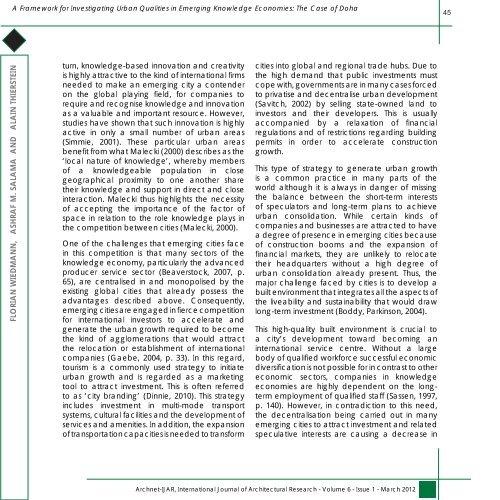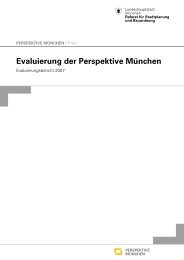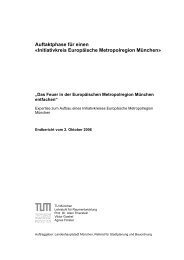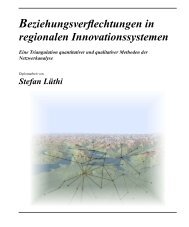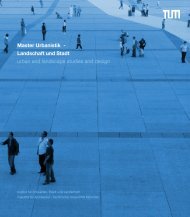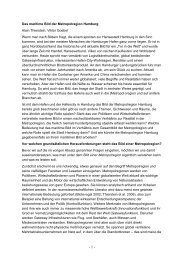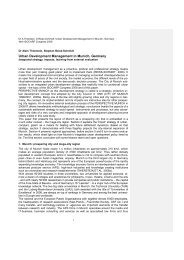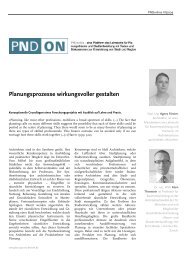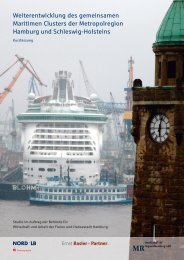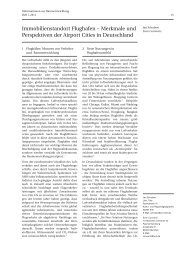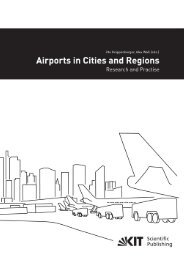0.6-1-Cover and Table of Contents-pp 0-05.indd - Raumentwicklung ...
0.6-1-Cover and Table of Contents-pp 0-05.indd - Raumentwicklung ...
0.6-1-Cover and Table of Contents-pp 0-05.indd - Raumentwicklung ...
Create successful ePaper yourself
Turn your PDF publications into a flip-book with our unique Google optimized e-Paper software.
FLORIAN WIEDMANN, ASHRAF M. SALAMA AND ALAIN THIERSTEIN<br />
A Framework for Investigating Urban Qualities in Emerging Knowledge Economies: The Case <strong>of</strong> Doha<br />
turn, knowledge-based innovation <strong>and</strong> creativity<br />
is highly attractive to the kind <strong>of</strong> international firms<br />
needed to make an emerging city a contender<br />
on the global playing field, for companies to<br />
require <strong>and</strong> recognise knowledge <strong>and</strong> innovation<br />
as a valuable <strong>and</strong> important resource. However,<br />
studies have shown that such innovation is highly<br />
active in only a small number <strong>of</strong> urban areas<br />
(Simmie, 2001). These particular urban areas<br />
benefit from what Malecki (2000) describes as the<br />
‘local nature <strong>of</strong> knowledge’, whereby members<br />
<strong>of</strong> a knowledgeable population in close<br />
geographical proximity to one another share<br />
their knowledge <strong>and</strong> su<strong>pp</strong>ort in direct <strong>and</strong> close<br />
interaction. Malecki thus highlights the necessity<br />
<strong>of</strong> accepting the importance <strong>of</strong> the factor <strong>of</strong><br />
space in relation to the role knowledge plays in<br />
the competition between cities (Malecki, 2000).<br />
One <strong>of</strong> the challenges that emerging cities face<br />
in this competition is that many sectors <strong>of</strong> the<br />
knowledge economy, particularly the advanced<br />
producer service sector (Beaverstock, 2007, p.<br />
65), are centralised in <strong>and</strong> monopolised by the<br />
existing global cities that already possess the<br />
advantages described above. Consequently,<br />
emerging cities are engaged in fierce competition<br />
for international investors to accelerate <strong>and</strong><br />
generate the urban growth required to become<br />
the kind <strong>of</strong> agglomerations that would attract<br />
the relocation or establishment <strong>of</strong> international<br />
companies (Gaebe, 2004, p. 33). In this regard,<br />
tourism is a commonly used strategy to initiate<br />
urban growth <strong>and</strong> is regarded as a marketing<br />
tool to attract investment. This is <strong>of</strong>ten referred<br />
to as ‘city br<strong>and</strong>ing’ (Dinnie, 2010). This strategy<br />
includes investment in multi-mode transport<br />
systems, cultural facilities <strong>and</strong> the development <strong>of</strong><br />
services <strong>and</strong> amenities. In addition, the expansion<br />
<strong>of</strong> transportation capacities is needed to transform<br />
cities into global <strong>and</strong> regional trade hubs. Due to<br />
the high dem<strong>and</strong> that public investments must<br />
cope with, governments are in many cases forced<br />
to privatise <strong>and</strong> decentralise urban development<br />
(Savitch, 2002) by selling state-owned l<strong>and</strong> to<br />
investors <strong>and</strong> their developers. This is usually<br />
accompanied by a relaxation <strong>of</strong> financial<br />
regulations <strong>and</strong> <strong>of</strong> restrictions regarding building<br />
permits in order to accelerate construction<br />
growth.<br />
This type <strong>of</strong> strategy to generate urban growth<br />
is a common practice in many parts <strong>of</strong> the<br />
world although it is always in danger <strong>of</strong> missing<br />
the balance between the short-term interests<br />
<strong>of</strong> speculators <strong>and</strong> long-term plans to achieve<br />
urban consolidation. While certain kinds <strong>of</strong><br />
companies <strong>and</strong> businesses are attracted to have<br />
a degree <strong>of</strong> presence in emerging cities because<br />
<strong>of</strong> construction booms <strong>and</strong> the expansion <strong>of</strong><br />
financial markets, they are unlikely to relocate<br />
their headquarters without a high degree <strong>of</strong><br />
urban consolidation already present. Thus, the<br />
major challenge faced by cities is to develop a<br />
built environment that integrates all the aspects <strong>of</strong><br />
the liveability <strong>and</strong> sustainability that would draw<br />
long-term investment (Boddy, Parkinson, 2004).<br />
This high-quality built environment is crucial to<br />
a city’s development toward becoming an<br />
international service centre. Without a large<br />
body <strong>of</strong> qualified workforce successful economic<br />
diversification is not possible for in contrast to other<br />
economic sectors, companies in knowledge<br />
economies are highly dependent on the longterm<br />
employment <strong>of</strong> qualified staff (Sassen, 1997,<br />
p. 140). However, in contradiction to this need,<br />
the decentralisation being carried out in many<br />
emerging cities to attract investment <strong>and</strong> related<br />
speculative interests are causing a decrease in<br />
Archnet-IJAR, International Journal <strong>of</strong> Architectural Research - Volume 6 - Issue 1 - March 2012<br />
45


